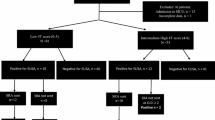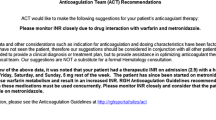Abstract
A high frequency of PF4-ELISA testing in patients suspected to have heparin-induced thrombocytopenia (HIT) despite low 4T scores has been observed in multiple medical centers. Education of clinicians has been suggested to reduce inappropriate testing. We determined trends of PF4-ELISA testing in our institution after the introduction of a HIT education program for clinicians. A HIT Program was developed that included ongoing education, individual feedback, and continuous clinical audit of PF4-ELISA utilization. To assess the impact of education on PF4-ELISA testing trends, we conducted a prospective cohort review of all adult patients who had a PF4-ELISA ordered over a 3 month period (the last quarter of the academic year). 72 PF4-ELISA tests were ordered during the study period. Prospectively calculated 4T scores by investigators revealed 60 low-risk (83.3%), 9 intermediate-risk (12.5%), and 3 high-risk (4.16%). We observed divergent 4T scores with the ordering clinician calculating a higher 4T score compared to the Hematology Quality Improvement (QI) team. The majority of PF4-ELISA testing was ordered by the intensive care units (ICUs) (n = 32, 44.44%). Our study revealed that the frequency of calculation of 4T scores remains poor with the majority inappropriately performed in the ICU setting, with ordering clinicians calculating higher 4T scores than the Hematology QI team. This suggests that clinician education alone is insufficient. Introducing mandatory 4T score calculation prior to PF4-ELISA testing may not be helpful as ordering clinicians can bypass the restriction through inaccurate 4T score calculation.
Similar content being viewed by others
References
Warkentin TE (2004) Heparin-induced thrombocytopenia: diagnosis and management. Circulation 110(18):e454–e458. https://doi.org/10.1161/01.CIR.0000147537.72829.1B
Girolami B, Prandoni P, Stefani PM, Tanduo C, Sabbion P, Eichler P, Ramon R, Baggio G, Fabris F, Girolami A (2003) The incidence of heparin-induced thrombocytopenia in hospitalized medical patients treated with subcutaneous unfractionated heparin: a prospective cohort study. Blood 101(8):2955–2959. https://doi.org/10.1182/blood-2002-07-2201
Martel N, Lee J, Wells PS (2005) Risk for heparin-induced thrombocytopenia with unfractionated and low-molecular-weight heparin thromboprophylaxis: a meta-analysis. Blood 106(8):2710–2715. https://doi.org/10.1182/blood-2005-04-1546
Warkentin TE, Levine MN, Hirsh J, Horsewood P, Roberts RS, Gent M, Kelton JG (1995) Heparin-induced thrombocytopenia in patients treated with low-molecular-weight heparin or unfractionated heparin. N Engl J Med 332(20):1330–1335. https://doi.org/10.1056/NEJM199505183322003
Greinacher A, Eichler P, Lubenow N, Kwasny H, Luz M (2000) Heparin-induced thrombocytopenia with thromboembolic complications: meta-analysis of 2 prospective trials to assess the value of parenteral treatment with lepirudin and its therapeutic aPTT range. Blood 96(3):846–851
Cuker A (2011) Heparin-induced thrombocytopenia (HIT) in 2011: an epidemic of overdiagnosis. Thromb Haemost 106(6):993–994. https://doi.org/10.1160/TH11-09-0677
Marler J, Unzaga J, Stelts S, Oliphant CS (2015) Consequences of treating false positive heparin-induced thrombocytopenia. J Thromb Thrombolysis 40(4):512–514. https://doi.org/10.1007/s11239-015-1236-0
Cuker A, Gimotty PA, Crowther MA, Warkentin TE (2012) Predictive value of the 4Ts scoring system for heparin-induced thrombocytopenia: a systematic review and meta-analysis. Blood 120(20):4160–4167. https://doi.org/10.1182/blood-2012-07-443051
Lo GK, Juhl D, Warkentin TE, Sigouin CS, Eichler P, Greinacher A (2006) Evaluation of pretest clinical score (4 T’s) for the diagnosis of heparin-induced thrombocytopenia in two clinical settings. J Thromb Haemost 4(4):759–765. https://doi.org/10.1111/j.1538-7836.2006.01787.x
Berry C, Tcherniantchouk O, Ley EJ, Salim A, Mirocha J, Martin-Stone S, Stolpner D, Margulies DR (2011) Overdiagnosis of heparin-induced thrombocytopenia in surgical ICU patients. J Am Coll Surg 213(1):10–17. https://doi.org/10.1016/j.jamcollsurg.2011.04.002 discussion 17–18.
Farley S, Cummings C, Heuser W, Wang S, Calixte R, Hanna A, Axelrad A (2017) Prevalence and overtesting of true heparin-induced thrombocytopenia in a 591-bed tertiary care, teaching hospital. J Intensive Care Med 885066617722707. https://doi.org/10.1177/0885066617722707
Hasan M, Malalur P, Agastya M, Malik AO, Dawod Y, Jaradat M, Yoo JW, Makar R (2016) A high-value cost conscious approach to minimize heparin induced thrombocytopenia antibody (HITAb) testing using the 4T score. J Thromb Thrombolysis 42(3):441–446. https://doi.org/10.1007/s11239-016-1396-6
Lim MY, Foster J, Rourk A, Greenberg CS (2018) Initial and long term impact of a multi-disciplinary task force in the diagnosis and management of heparin-induced thrombocytopenia. J Thromb Thrombolysis 45(1):130–134. https://doi.org/10.1007/s11239-017-1592-z
Landau DA, Kholodnaya N, CuestaFernandez A, PerezPerez A (2015) The appropriateness of heparin antibody testing. A single institution retrospective analysis. Blood 126(23):3277
Mariampillai AI, Dela Cruz JP, Staszewski H, D’Abreo N (2016) Heparin-induced thrombocytopenia antibody testing and its cost effectiveness: taking a financial hit. Blood 128(22):2343
Schaffner M, Perepu U (2017) Striving to hit the bullseye when diagnosing heparin-induced thrombocytopenia. Blood 130(Suppl 1):4639
Smith M, Dowell JE, Frenkel EP, Sarode R, Shen YP (2011) Initial management of suspected heparin-induced thrombocytopenia: opportunities for education. Blood 118(21):4686
Nandi PL, Chan JN, Chan CP, Chan P, Chan LP (2000) Undergraduate medical education: comparison of problem-based learning and conventional teaching. Hong Kong Med J 6(3):301–306
SQUIRE. Explanation and elaboration of SQUIRE 2.0 guidelines (2015) http://www.squire-statement.org/index.cfm?fuseaction=page.viewpage&pageid=504. Accessed 11 Oct 2018
ABIM Choosing Wisely Initiative http://abimfoundation.org/what-we-do/choosing-wisely. Accessed 23 Oct 2018
McClellan WM, Millman L, Presley R, Couzins J, Flanders WD (2003) Improved diabetes care by primary care physicians: results of a group-randomized evaluation of the Medicare Health Care Quality Improvement Program (HCQIP). J Clin Epidemiol 56(12):1210–1217
Newman DHBJ, Ackerman B, Hsieh W, Yang H, Kyrillou E, Krashaur M, Tse AB, Sharp VE (2008) Can physician education improve patient use of a free rapid HIV testing program? Ann Emerg Med 52(4):S121
van der Weijden T, Grol RP, Knottnerus JA (1999) Feasibility of a national cholesterol guideline in daily practice. A randomized controlled trial in 20 general practices. Int J Qual Health Care 11(2):131–137
Greinacher A, Selleng S (2016) How I evaluate and treat thrombocytopenia in the intensive care unit patient. Blood 128(26):3032–3042. https://doi.org/10.1182/blood-2016-09-693655
Harada MY, Hoang DM, Zaw AA, Murry JS, Volod O, Sun BJ, Nuno M, Mason R, Margulies DR, Ley EJ (2017) Overtreatment of heparin-induced thrombocytopenia in the surgical ICU. Crit Care Med 45(1):28–34. https://doi.org/10.1097/CCM.0000000000002002
Pierce W, Mazur J, Greenberg C, Mueller J, Foster J, Lazarchick J (2013) Evaluation of heparin-induced thrombocytopenia (HIT) laboratory testing and the 4Ts scoring system in the intensive care unit. Ann Clin Lab Sci 43(4):429–435
Piednoir P, Allou N, Provenchere S, Berroeta C, Huisse MG, Philip I, Ajzenberg N (2012) Heparin-induced thrombocytopenia after cardiac surgery: an observational study of 1722 patients. J Cardiothorac Vasc Anesth 26(4):585–590. https://doi.org/10.1053/j.jvca.2011.11.009
Selleng S, Selleng K (2016) Heparin-induced thrombocytopenia in cardiac surgery and critically ill patients. Thromb Haemost 116(5):843–851. https://doi.org/10.1160/TH16-03-0230
Burnett AE, Bowles H, Borrego ME, Montoya TN, Garcia DA, Mahan C (2016) Heparin-induced thrombocytopenia: reducing misdiagnosis via collaboration between an inpatient anticoagulation pharmacy service and hospital reference laboratory. J Thromb Thrombolysis 42(4):471–478. https://doi.org/10.1007/s11239-016-1381-0
Ritchie BM, Sylvester KW, Reardon DP, Churchill WW, Berliner N, Connors JM (2016) Treatment of heparin-induced thrombocytopenia before and after the implementation of a hemostatic and antithrombotic stewardship program. J Thromb Thrombolysis 42(4):616–622. https://doi.org/10.1007/s11239-016-1408-6
Wychowski MK, Ruscio CI, Kouides PA, Sham RL (2017) The scope and value of an anticoagulation stewardship program at a community teaching hospital. J Thromb Thrombolysis 43(3):380–386. https://doi.org/10.1007/s11239-016-1455-z
Samuelson BT, Glynn E, Holmes M, White AA, Martin DB, Garcia D (2015) Use of a computer-based provider order entry (CPOE) intervention to optimize laboratory testing in patients with suspected heparin-induced thrombocytopenia. Thromb Res 136(5):928–931. https://doi.org/10.1016/j.thromres.2015.09.005
Lim MY, Greenberg CS (2018) Inpatient thrombophilia testing: impact of healthcare system technology and targeted clinician education on changing practice patterns. Vasc Med 23(1):78–79. https://doi.org/10.1177/1358863X17742509
Author information
Authors and Affiliations
Corresponding author
Rights and permissions
About this article
Cite this article
Malalur, P., Greenberg, C. & Lim, M.Y. Limited impact of clinician education on reducing inappropriate PF4 testing for heparin-induced thrombocytopenia. J Thromb Thrombolysis 47, 287–291 (2019). https://doi.org/10.1007/s11239-018-01803-8
Published:
Issue Date:
DOI: https://doi.org/10.1007/s11239-018-01803-8




